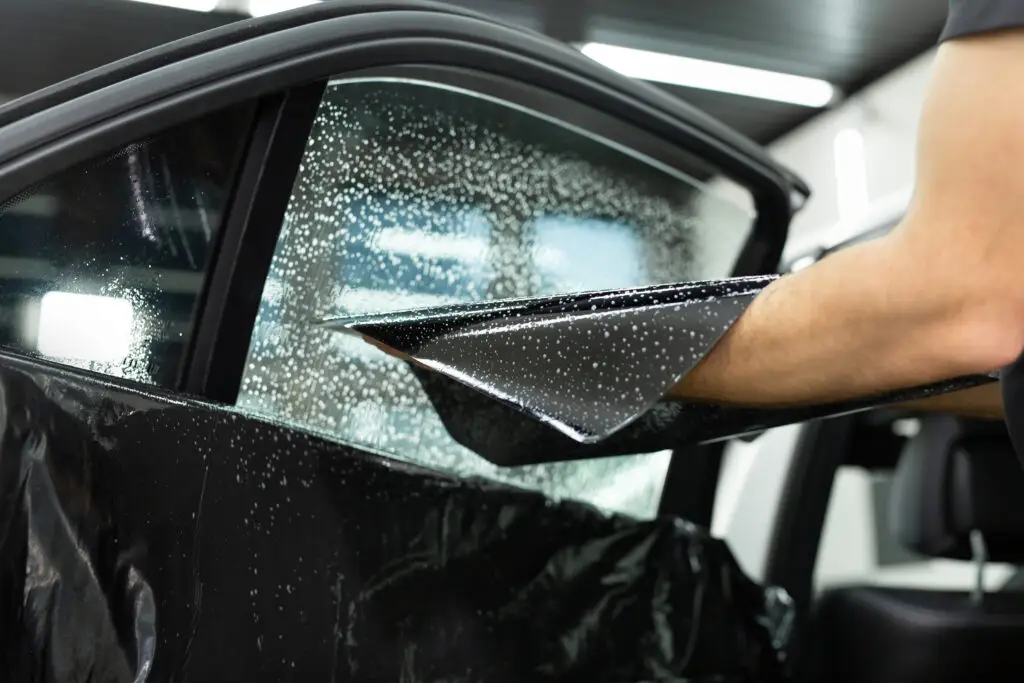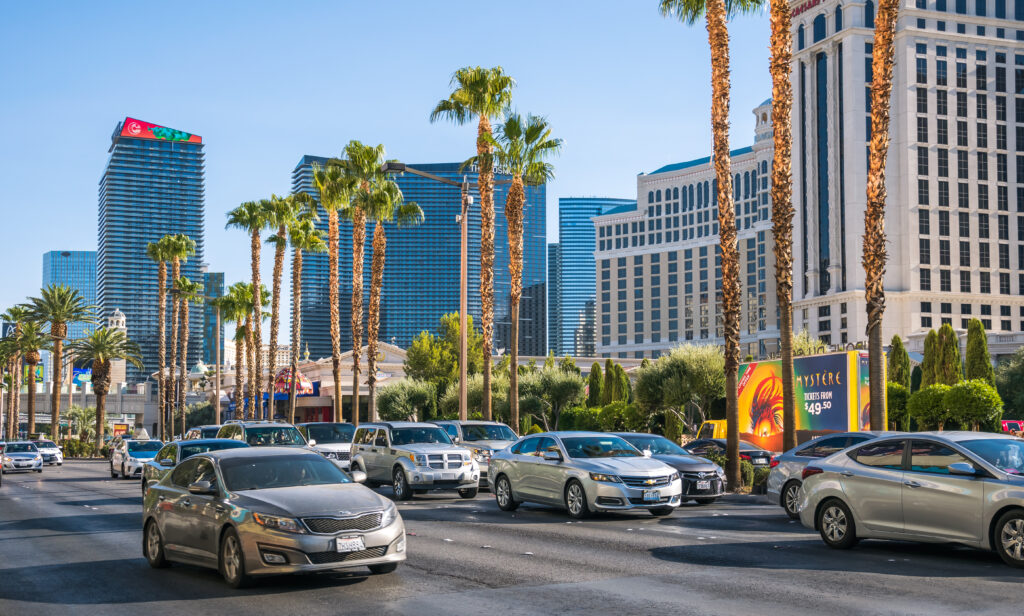In a place like Las Vegas, window tint isn’t just a style choice. Instead, it’s a practical necessity to help keep the inside of your vehicle at a safe temperature and reduce sun damage to your dash and upholstery. Between scorching desert heat, intense sunlight, and privacy concerns, you might be thinking about window tint to improve your driving experience.
Before you darken your car’s windows, it’s important to understand Nevada tint laws, particularly in Clark County, where enforcement is common. Here’s what you need to know about Nevada car window tint laws, including Visible Light Transmission (VLT) limits, color and reflectivity restrictions, medical exemptions, and how to avoid costly penalties.
At Best Tint Shop in Las Vegas we follow IWFA (International Window Film Association) guidelines and have the expertise in the legal window tinting you need and deserve, so you can enjoy a comfortable, compliant, and cool ride.
Understanding Nevada’s Window Tint Law Basics
Nevada established its foundational window tint laws in 1993, with periodic updates to account for modern tinting films and technology. These laws apply statewide, so the regulations you follow in Las Vegas are the same across Reno, Henderson, and beyond. You won’t end up in trouble in one city because you got your tint in a different one, provided you chose a reputable shop providing state-legal window tint.
What is VLT?
The most critical legal concept to understand when it comes to tinting your vehicle’s windows is Visible Light Transmission (VLT). This measures the amount of visible light that can pass through your tinted windows. In short:
- Higher VLT = Lighter tint (e.g., 70% lets in more light)
- Lower VLT = Darker tint (e.g., 20% lets in less light)
State law specifies minimum VLT percentages for different window groups (front, back, etc.) to ensure drivers maintain enough visibility for safe driving and law enforcement identification.
Nevada Window Tint Requirements by Window Type
Whether you drive a sedan, SUV, truck, or van, Nevada’s tint laws apply equally. Tint regulations vary by window, so it’s crucial to understand what’s legal where.
Windshield Tinting Laws in Las Vegas
If you want to have your windshield tinted to keep out some of the heat and sunshine you’ll need to be very careful of the rules. Tinting a windshield incorrectly or illegally installing heavily tinted windows can lead to fine and penalties, and can also put you and other drivers at risk. In Nevada, you’ll need to follow these rules for tinted windshields:
- You may only tint the top portion of the windshield, above the AS-1 line. (This line is typically five to six inches from the top of the windshield or clearly marked by the manufacturer.)
- Tint must be a non-reflective tint, preventing glare and maintaining clear visibility.
- Full windshield tinting is prohibited, except when granted a medical exemption.
This rule helps ensure you have a clear view of the road while avoiding blinding sun glare during sunrise and sunset, to make the roads safer for everyone.

Front Side Window Tint Restrictions
The front windows have different tinting requirements from the back windows, with stricter governance. For front windows, both driver and passenger side windows must allow more than 35% VLT. This means at least 35% of visible light must pass through the glass and tint combined. The law strikes a balance between your privacy, visibility for law enforcement, and road safety. Even slight deviations below 35%, for example, a tint that tests at 32%, could lead to a citation.
Rear Window Tinting Freedom in Nevada
Nevada is relatively lenient when it comes to rear window tint. For the rear windows any darkness level is permitted on the sides and the back window. If the back window is tinted, your vehicle must have dual side mirrors to ensure rear visibility. This flexibility lets you prioritize privacy and heat reduction for your passengers, pets, and belongings in the back seat or cargo area.
Prohibited Tint Colors and Reflectivity Rules
Not all tint colors and finishes are legal in Nevada. To prevent confusion with emergency vehicles and to reduce road hazards caused by glare, the law states that:
- Red and amber tints are fully prohibited on any windows.
- Excessively reflective or mirrored tints are generally discouraged but not explicitly banned.
- Metallic or mirrored films are legal as long as they don’t create significant glare or visibility problems.
For best results and full compliance, you should avoid tint films with strong iridescent or colorful sheens, and always confirm product legality with a trusted installer like Best Tint Shop. Whether a tint is too reflective or creates too much glare can be up to an officer’s discretion, and it’s better to err on the side of caution.
Medical Exemptions for Darker Tint in Nevada
Drivers with specific medical conditions may legally install tint darker than the state’s normal limits. Conditions that may qualify include:
- Photosensitivity
- Lupus
- Albinism
- Rosacea
- Skin cancer risk
You’ll need to apply for a medical exemption and explain the exact nature of your illness. To do that:
- Consult your physician, who must provide documentation confirming your medical need for reduced light exposure.
- Submit an application to the Nevada Department of Public Safety.
- Once approved, keep the exemption paperwork in your vehicle at all times in case of a traffic stop.
The medical exemption allows you to tint the front side windows and windshield darker than the legal minimums, but only as approved in the exemption terms.
Las Vegas Window Tint Violation Penalties
Illegal tint in Las Vegas isn’t just a cosmetic concern. It can lead to big fines and penalties. For example:
- First-time violations can cost over $100.
- You may be ordered to remove or replace non-compliant tint, often at your own expense.
- Nevada allows a 7% variance, meaning tint that measures as low as 28% VLT on front windows may pass inspection.
- Repeat violations may result in increased fines or vehicle impoundment in severe cases.
To avoid these risks, you should always confirm compliance before installation or have your tint professionally tested.
Why Las Vegas Climate Makes Legal Tinting Essential
Las Vegas summers can be brutal. With average temperatures soaring above 100°F, your vehicle’s interior can quickly become a health hazard without proper UV protection. Proper tinting can:
- Reduce cabin temperatures
- Block harmful UV rays,
- Reduce skin damage and preventing interior fading
- Improve energy efficiency, lowering demand on your A/C system
- Increase driving comfort and reduced glare on sunny roads
When installed legally, window tint becomes a powerful way to protect your health, comfort, and vehicle value. We also provide ceramic coating, paint protection film and vehicle wraps, to further protect your vehicle for years to come.

Ensuring Your Tint Complies with Nevada Law
Not all tint is created equal. Buying a film online or from a generic installer can put you at risk if the product doesn’t meet legal standards. Aftermarket tint options vary widely in quality and legality, so it’s important to verify the VLT rating and ensure the film is approved for use in Nevada. That’s why it’s better to come see us at Best Tint Shop. We use certified, legal tint films with known VLT ratings, and perform VLT testing to verify compliance. Not only that, but we’re focused on Nevada’s evolving laws, so we always stay current, and we’ll offer expert guidance to choose tint that fits legal requirements and your style.
Stay Legal with Professional Installation
Your safest route to compliance is professional installation from a certified shop with local experience. When you choose us at Best Tint Shop, you get:
- Over 15 years of serving the Las Vegas area
- Certified XPEL tint installers
- Satisfaction guarantee and product warranty
- Clean, efficient installation done right the first time
- Free consultations to help you choose the right VLT and finish
Ready to have great window tint that won’t leave you worried about compliance? Give us a call at 702-992-3288 or contact us online to book your appointment today. We’re happy to provide an estimate so you can make an informed choice about tinting your vehicle’s windows. We also offer window tinting for your home or business location, to keep out the sun’s rays and help protect your HVAC system, furnishings, and more.
Frequently Asked Questions About Las Vegas Tint Laws
What is the darkest legal tint for front windows in Las Vegas?
Front windows must allow more than 35% VLT. Any lower may be subject to fines unless it’s within accepted tolerance.
Can I tint my windshield in Nevada?
Only the top portion above the AS-1 line may be tinted, and it must be non-reflective. Medical exemptions allow fuller coverage.
What happens if I get pulled over for illegal window tint?
You may receive a fine, be required to remove or replace the tint, and be subject to follow-up inspections.
Do I need dual side mirrors if my back window is tinted?
Yes. If the rear windshield is tinted, your vehicle must have functional side mirrors on both sides.
Are red and amber tints illegal in Las Vegas?
Yes. These colors are prohibited due to safety concerns and similarity to emergency vehicle lights.
How can I get a medical exemption for darker window tint?
Apply through the Nevada Department of Public Safety with your doctor’s certification. Approval may take several weeks.
Do Nevada tint laws apply to out-of-state vehicles?
Temporary visitors are typically given leniency, but long-term residents or frequent drivers may be cited for non-compliance.
What is the tolerance for VLT measurements in Nevada?
Nevada allows a 7% VLT variance, meaning front windows can measure as low as 28% VLT before being considered illegal.
